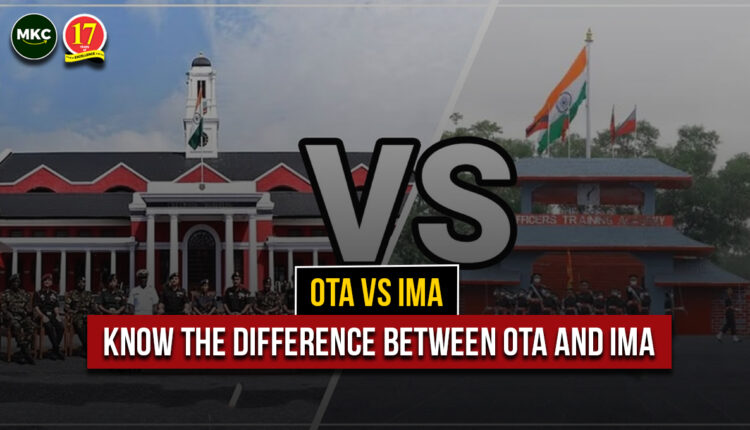OTA vs IMA , Know the Difference between OTA and IMA
“OTA vs IMA” is one of the most sought-after questions for aspiring defense candidates. Read this full article to understand the detailed differences between OTA and IMA.

OTA vs IMA: When it comes to military training, two prestigious institutions stand out: the Officers Training Academy (OTA) and the Indian Military Academy (IMA). Both OTA and IMA are esteemed academies in India committed to molding future leaders of the armed forces. Despite sharing the common goal of producing competent military officers, they differ significantly in their selection process, curriculum, training, and target demographics. Let’s delve into the differences between OTA and IMA across various factors.
OTA VS IMA
Table of Contents
Before delving into the detailed comparison between the Officers Training Academy (OTA) and the Indian Military Academy (IMA), it’s essential to understand the significance of these two prestigious institutions of the Indian Armed Forces.
| Detail | Officers Training Academy (OTA) | Indian Military Academy (IMA) |
| Establishment | Established in 1963 | Established in 1932 |
| Location | Located in Chennai, Tamil Nadu | Located in Dehradun, Uttarakhand |
| Type of Commissioning | 1. Short Service Commission (SSC) Officers14 Years 2. In certain instances, the service may be extendable to the Permanent Commission. | 1. Permanent Commission (PC) Officers 2. 30 years maximum |
OTA vs IMA Selection Process
The selection process for admission to the Officers Training Academy (OTA) and the Indian Military Academy (IMA) serves as the gateway through which aspiring candidates embark on their journey towards becoming military officers. Understanding the intricacies of these selection procedures is essential for individuals aspiring to serve as officers in the Indian Armed Forces.
| Detail | Officers Training Academy (OTA) | Indian Military Academy (IMA) |
| Entry | Direct entry after graduation | Entry through Combined Defence Services (CDS) Examination or National Defence Academy (NDA) Examination |
| Eligibility | Graduation from a recognized university | Graduation from a recognized university |
| Age Limit | 19 to 25 years | 19 to 24 years |
| Written Exam | 1. Candidates need to clear the CDSE examination conducted by the Union Public Service Commission (UPSC) followed by SSB interview 2. Candidates aspiring for OTA need not to appear for Mathematics in the CDSE examination. 3. Please note that there are some direct entries through which candidates can directly join OTA like SSC Tech Entry. | 1. Candidates need to clear the CDSE examination conducted by the Union Public Service Commission (UPSC) followed by SSB interview 2. Candidates aspiring for IMA need to appear for Mathematics in the CDSE examination. |
| Physical Tests | Physical fitness tests including running, push-ups, sit-ups, and chin-ups | Physical fitness tests including running, push-ups, sit-ups, and chin-ups |
| Medical Standards | Candidates must meet the prescribed medical standards set by the Indian Army | Candidates must meet the prescribed medical standards set by the Indian Army |
OTA vs IMA Training
The curriculum and training methodologies employed by OTA and IMA play an essential role in shaping the capabilities and competencies of the officers they produce. Let’s explore how these aspects differ between the two institutions.
| Detail | Officers Training Academy (OTA) | Indian Military Academy (IMA) |
| Duration | 49 weeks for men and 11 months for women | Approximately 18 months |
| Entry | Direct entry after graduation | Entry through Combined Defence Services (CDS) Examination or National Defence Academy (NDA) Examination |
| Training Method | Intensive training in military tactics, leadership, and physical fitness | Comprehensive military and academic training covering various disciplines such as tactics, strategy, leadership, and physical conditioning |
OTA VS IMA Target Demographics
Understanding the demographics targeted by OTA and IMA is crucial as it influences the composition and diversity of officers within the Indian Armed Forces. Let’s examine how OTA and IMA differ in their target demographics.
| Aspect | Officers Training Academy (OTA) | Indian Military Academy (IMA) |
| Gender | Both men and women | Men only |
| Commission Type | Short Service Commission (SSC) | Permanent Commission (PC) |
OTA vs IMA Career
The purpose and career trajectory offered by OTA and IMA set the foundation for the type of service and leadership roles undertaken by their graduates within the Indian Armed Forces. Let’s analyze the disparities in purpose and career trajectory between OTA and IMA.
| Aspect | Officers Training Academy (OTA) | Indian Military Academy (IMA) |
| Career | Offers opportunities for short-term service in the Indian Army | Provides avenues for long-term service and leadership roles in the Indian Army |
| Specializations | Offers diverse career options within the Indian Army, including combat and support roles | Provides training for combat arms and combat support arms |
In summary, OTA and IMA aim to train skilled military officers, but they serve different parts of the Indian Army. OTA trains short-service commission officers, focusing on efficiency and versatility, while IMA prepares candidates for permanent commission, emphasizing leadership and long-term service. Aspiring military candidates need to understand OTA vs IMA differences to choose the path that best fits their career ambitions and objectives.








